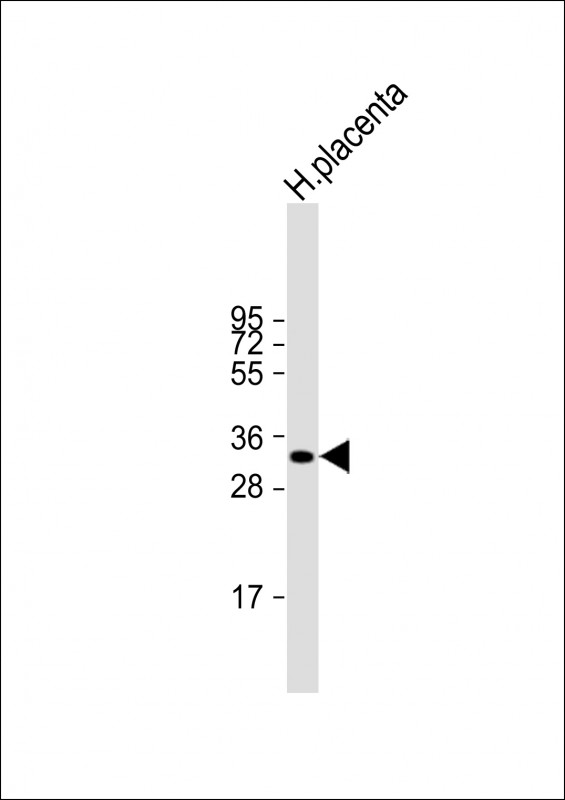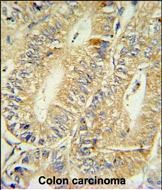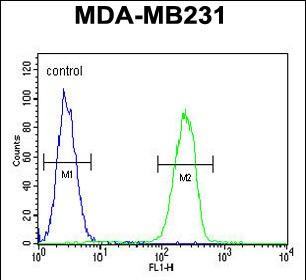HPGD Antibody (C-term)
Purified Rabbit Polyclonal Antibody (Pab)
- SPECIFICATION
- CITATIONS
- PROTOCOLS
- BACKGROUND

Application
| FC, IHC-P, WB, E |
|---|---|
| Primary Accession | P15428 |
| Other Accession | Q8MJY8 |
| Reactivity | Human |
| Predicted | Monkey |
| Host | Rabbit |
| Clonality | Polyclonal |
| Isotype | Rabbit IgG |
| Calculated MW | 28977 Da |
| Antigen Region | 184-212 aa |
| Gene ID | 3248 |
|---|---|
| Other Names | 15-hydroxyprostaglandin dehydrogenase [NAD(+)], 15-PGDH, Prostaglandin dehydrogenase 1, HPGD, PGDH1 |
| Target/Specificity | This HPGD antibody is generated from rabbits immunized with a KLH conjugated synthetic peptide between 184-212 amino acids from the C-terminal region of human HPGD. |
| Dilution | FC~~1:10~50 IHC-P~~1:50~100 WB~~1:2000 E~~Use at an assay dependent concentration. |
| Format | Purified polyclonal antibody supplied in PBS with 0.09% (W/V) sodium azide. This antibody is prepared by Saturated Ammonium Sulfate (SAS) precipitation followed by dialysis against PBS. |
| Storage | Maintain refrigerated at 2-8°C for up to 2 weeks. For long term storage store at -20°C in small aliquots to prevent freeze-thaw cycles. |
| Precautions | HPGD Antibody (C-term) is for research use only and not for use in diagnostic or therapeutic procedures. |
| Name | HPGD (HGNC:5154) |
|---|---|
| Synonyms | PGDH1, SDR36C1 |
| Function | Catalyzes the NAD-dependent dehydrogenation (oxidation) of a broad array of hydroxylated polyunsaturated fatty acids (mainly eicosanoids and docosanoids, including prostaglandins, lipoxins and resolvins), yielding their corresponding keto (oxo) metabolites (PubMed:10837478, PubMed:16757471, PubMed:16828555, PubMed:21916491, PubMed:25586183, PubMed:8086429). Decreases the levels of the pro- proliferative prostaglandins such as prostaglandin E2 (whose activity is increased in cancer because of an increase in the expression of cyclooxygenase 2) and generates oxo-fatty acid products that can profoundly influence cell function by abrogating pro-inflammatory cytokine expression (PubMed:15574495, PubMed:25586183). Converts resolvins E1, D1 and D2 to their oxo products, which represents a mode of resolvin inactivation. Resolvin E1 plays important roles during the resolution phase of acute inflammation, while resolvins D1 and D2 have a unique role in obesity-induced adipose inflammation (PubMed:16757471, PubMed:22844113). |
| Cellular Location | Cytoplasm. |
| Tissue Location | Detected in colon epithelium (at protein level). |

Thousands of laboratories across the world have published research that depended on the performance of antibodies from Abcepta to advance their research. Check out links to articles that cite our products in major peer-reviewed journals, organized by research category.
info@abcepta.com, and receive a free "I Love Antibodies" mug.
Provided below are standard protocols that you may find useful for product applications.
Background
HPGD is a member of the short-chain nonmetalloenzyme alcohol dehydrogenase protein family. This protein is responsible for the metabolism of prostaglandins, which function in a variety of physiologic and cellular processes such as inflammation.
References
Thill,M., et.al., Anticancer Res. 29 (9), 3619-3625 (2009)
If you have used an Abcepta product and would like to share how it has performed, please click on the "Submit Review" button and provide the requested information. Our staff will examine and post your review and contact you if needed.
If you have any additional inquiries please email technical services at tech@abcepta.com.














 Foundational characteristics of cancer include proliferation, angiogenesis, migration, evasion of apoptosis, and cellular immortality. Find key markers for these cellular processes and antibodies to detect them.
Foundational characteristics of cancer include proliferation, angiogenesis, migration, evasion of apoptosis, and cellular immortality. Find key markers for these cellular processes and antibodies to detect them. The SUMOplot™ Analysis Program predicts and scores sumoylation sites in your protein. SUMOylation is a post-translational modification involved in various cellular processes, such as nuclear-cytosolic transport, transcriptional regulation, apoptosis, protein stability, response to stress, and progression through the cell cycle.
The SUMOplot™ Analysis Program predicts and scores sumoylation sites in your protein. SUMOylation is a post-translational modification involved in various cellular processes, such as nuclear-cytosolic transport, transcriptional regulation, apoptosis, protein stability, response to stress, and progression through the cell cycle. The Autophagy Receptor Motif Plotter predicts and scores autophagy receptor binding sites in your protein. Identifying proteins connected to this pathway is critical to understanding the role of autophagy in physiological as well as pathological processes such as development, differentiation, neurodegenerative diseases, stress, infection, and cancer.
The Autophagy Receptor Motif Plotter predicts and scores autophagy receptor binding sites in your protein. Identifying proteins connected to this pathway is critical to understanding the role of autophagy in physiological as well as pathological processes such as development, differentiation, neurodegenerative diseases, stress, infection, and cancer.





